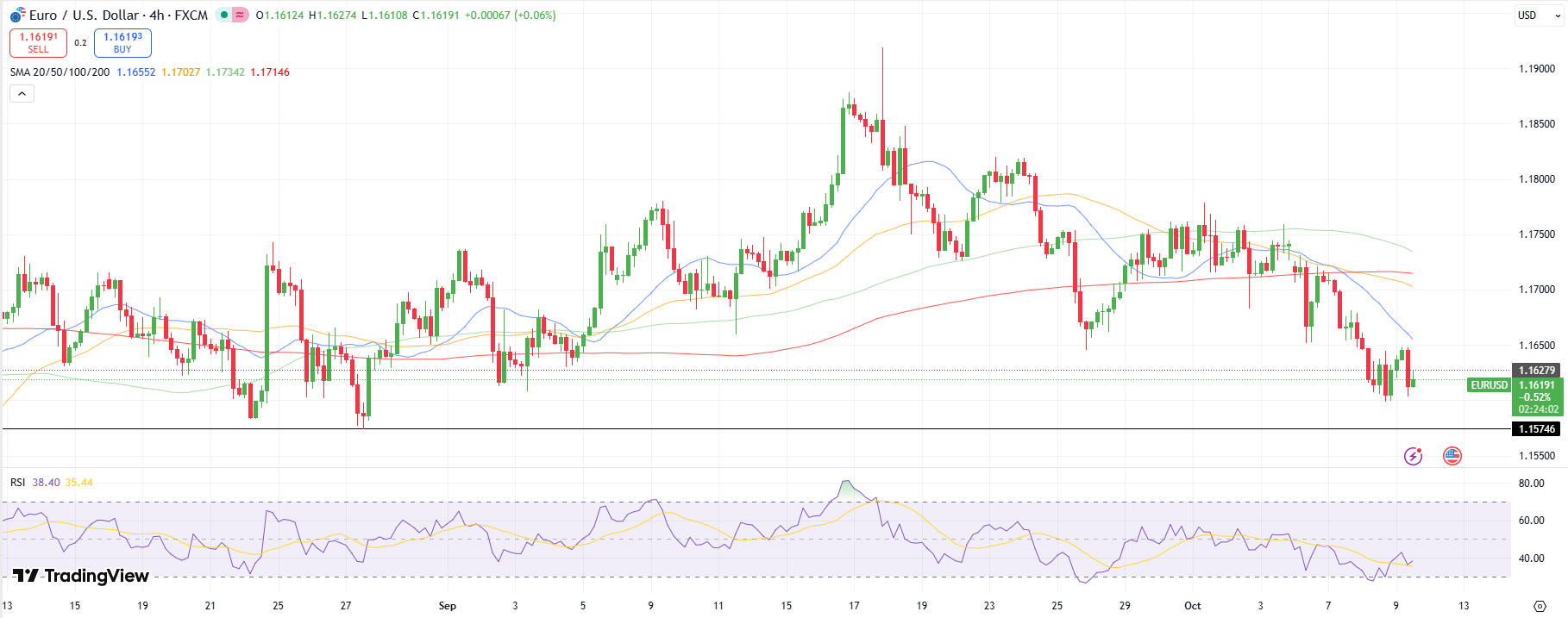EUR/USD Price Softer Amid Political Uncertainty, Divergent Policy Outlooks
- EUR/USD price remains soft amid the French political crisis and rising growth concerns.
- US dollar finds footing despite easing geopolitical risk after Hamas-Israel deal.
- Diverging ECB and Fed tones could keep the euro under pressure in Q4 2025.
The EUR/USD price extended its decline to 1.1600 on Thursday amid persistent political uncertainty in France and renewed dollar strength. The pair’s upside remained capped by 1.16505 in today’s European session as traders digested cautious remarks from Fed officials.
The domestic headwinds, specifically France’s ongoing political crisis, weigh on the euro. The outgoing Prime Minister Lecornu attempted to calm investors by assuring President Macron would announce a new government within 48 hours. However, lacking a parliamentary majority and growing fiscal concerns remain unsettled.
Meanwhile, Germany’s latest data reinforced the weaker growth profile, with August industrial production falling 4.3% and exports slipping 0.5%. This shows a sluggish demand across the bloc. Although Germany’s trade surplus surged to 17.2 billion EUR, the improvement came amid lower imports rather than strong external demand.
Across the Atlantic, the US government shutdown enters its ninth day, delaying key data releases. However, the FOMC September meeting minutes provided some direction. The overall tone was cautious with a divergent view on the pace of easing. Fed New York President John Williams said that the central bank can tighten the labor market as inflation pressure is gradually easing. Markets expect two more rate cuts by year’s end, though Powell’s commentary could readjust the outlook.
Despite the ceasefire agreement between Hamas and Israel, the US dollar index (DXY) gained to 99.00 due to geopolitical uncertainty triggered by safe-haven flows. Meanwhile, resilient US Treasury yields, ISM manufacturing, and consumer confidence support the greenback.
On the other hand, the ECB faces pressure amid soft growth and easing inflation. The Eurozone GDP gained only 0.1% q/q, with stagnating credit growth. UOB Group analysts say, “EUR/USD could consolidate between 1.1600 and 1.1660 in the short-term, but the downside risk to 1.1570 persists if sentiment deteriorates.”
Overall, the divergence in monetary policy and growth trajectories between the Fed and ECB remains the dominant driver. Unless the Eurozone economy shows stronger momentum or US data weakens significantly, EUR/USD will likely stay under pressure through Q4 2025.
EUR/USD Price Technical Analysis: Consolidation Below 20-MA
(Click on image to enlarge)

EUR/USD 4-hour chart
The 4-hour chart for the EUR/USD shows mild support for the pair near 1.1600 as the RSI moved up after hitting the oversold region. However, the 20-period MA stays steeper near 1.1650, posing a hurdle for the upside.
On gaining acceptance above the 20-period MA, the price could pick up buying momentum and look to test 1.1700. However, a breakout of 1.1600 could lead to 1.1575 support ahead of 1.1500.
More By This Author:
AUD/USD Forecast: AUD Strengthens As Inflation Expectations RiseEUR/USD Price Slips Amid French Political Turmoil And USD Rebound
USD/CAD Outlook: Weakening Buyers Amid Fed, Stable Oil Prices
Disclaimer: Foreign exchange (Forex) trading carries a high level of risk and may not be suitable for all investors. The risk grows as the leverage is higher. Investment objectives, risk ...
more


